TOYOTA TUNDRA 2021 (in English) Owner's Guide
Manufacturer: TOYOTA, Model Year: 2021, Model line: TUNDRA, Model: TOYOTA TUNDRA 2021Pages: 52, PDF Size: 3.8 MB
Page 31 of 52
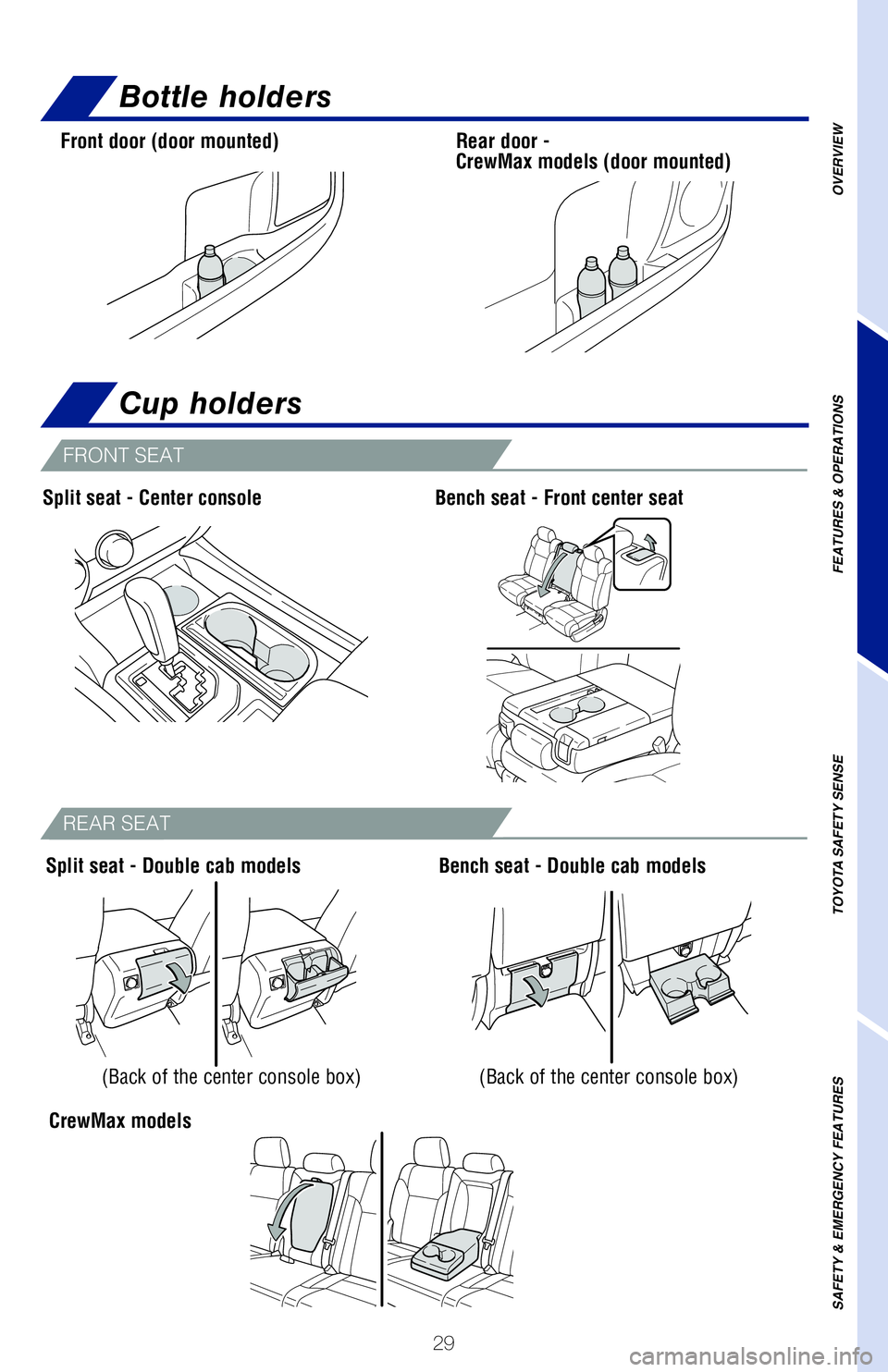
29
Cup holders
Bottle holders
Rear door -
CrewMax models (door mounted)Front door (door mounted)
Bench seat - Front center seatSplit seat - Center console
Split seat - Double cab models(Back of the center console box) (Back of the center console box)Bench seat - Double cab models
CrewMax models
REAR SEAT
FRONT SEAT
Garage door opener (HomeLink®)* (if equipped)
Garage door openers manufactured under license from HomeLink®* can be
programmed to operate garage doors, estate gates, security lighting, etc\
.
Refer to the Owner’s Manual for more details.
For programming assistance, contact HomeLink
® at 1-800-355-3515, or visit
http://www.homelink.com/toyota.
* HomeLink
® is a registered trademark of Gentex Corporation.
OVERVIEW
FEATURES & OPERATIONS
TOYOTA SAFETY SENSE
SAFETY & EMERGENCY FEATURES
The VSC OFF switch is used to switch between modes related to the TRAC, \
VSC
and Auto LSD functions.
Refer to the Owner’s Manual for limitations and more details.
MY21_Tundra_QRG_V2_ML_0709.indd 297/13/20 10:54 AM
Page 32 of 52
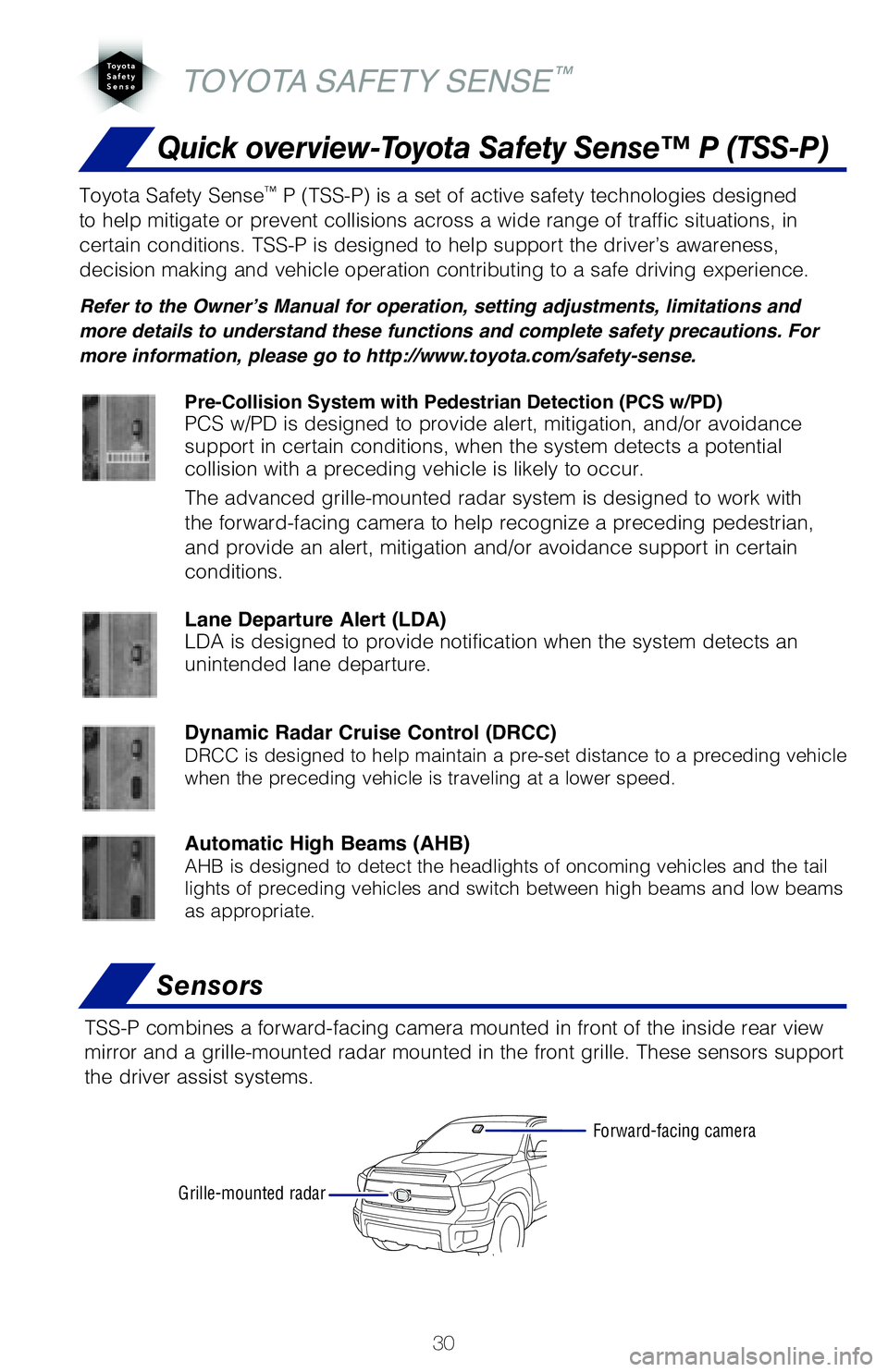
30
The Pre-Collision System with Pedestrian Detection (PCS w/PD) is desig\
ned to
help detect a vehicle or a pedestrian in certain situations. Using a com\
bination of
a camera and radar, PCS w/ PD can provide an audio/visual alert to warn \
you of
a possible collision under certain circumstances. If you don’t react,\
the system is
designed to automatically brake.
As there is a limit to the degree of recognition accuracy and control pe\
rformance
that this system can provide, do not overly rely on this system. This sy\
stem will not
prevent collisions or lessen collision damage or injury in every situati\
on. Do not use
PCS instead of normal braking operations under any circumstances. Do not\
attempt
to test the operation of the Pre-Collision System yourself, as the syste\
m may not
operate or engage, possibly leading to an accident. In some situations, \
such as
when driving in inclement weather such as heavy rain, fog, snow or a san\
dstorm or
while driving on a curve and for a few seconds after driving on a curve,\
a vehicle
or pedestrian may not be detected by the grille-mounted radar and forwar\
d-facing
camera, preventing the system from operating or engaging properly.
See Toyota.com/safety-sense for more information.
Refer to the Toyota Owner’s Manual for a list of additional situation\
s in which the
system operation may be limited.
Quick overview-Toyota Safety Sense™ P (TSS-P)
Sensors
TSS-P combines a forward-facing camera mounted in front of the inside re\
ar view
mirror and a grille-mounted radar mounted in the front grille. These sen\
sors support
the driver assist systems.
TOYOTA SAFETY SENSE™
Toyota Safety Sense™ P (TSS-P) is a set of active safety technologies designed
to help mitigate or prevent collisions across a wide range of traffic si\
tuations, in
certain conditions. TSS-P is designed to help support the driver’s aw\
areness,
decision making and vehicle operation contributing to a safe driving exp\
erience.
Refer to the Owner’s Manual for operation, setting adjustments, limitations and
more details to understand these functions and complete safety precautions. For
more information, please go to http://www.toyota.com/safety-sense.
Automatic High Beams (AHB)AHB is designed to detect the headlights of oncoming vehicles and the ta\
il
lights of preceding vehicles and switch between high beams and low beams\
as appropriate. Pre-Collision System with Pedestrian Detection (PCS w/PD)
PCS w/PD is designed to provide alert, mitigation, and/or avoidance
support in certain conditions, when the system detects a potential
collision with a preceding vehicle is likely to occur.
The advanced grille-mounted radar system is designed to work with
the forward-facing camera to help recognize a preceding pedestrian,
and provide an alert, mitigation and/or avoidance support in certain
conditions.
Dynamic Radar Cruise Control (DRCC)
DRCC is designed to help maintain a pre-set distance to a preceding vehi\
cle
when the preceding vehicle is traveling at a lower speed.
Lane Departure Alert (LDA)
LDA is designed to provide notification when the system detects an
unintended lane departure.
Pre-Collision Warning
When the system determines that the possibility of a frontal collision i\
s high, a
buzzer will sound and a warning message will be displayed on the Multi-I\
nformation
Display (MID) to urge the driver to take evasive action.
Pre-Collision Brake Assist
If the driver notices the hazard and brakes, the system may provide addi\
tional
braking force using Brake Assist. This system may prime the brakes and m\
ay apply
greater braking force in relation to how strongly the brake pedal is dep\
ressed.
Forward-facing camera
Grille-mounted radar
MY21_Tundra_QRG_V2_ML_0709.indd 307/13/20 10:54 AM
Page 33 of 52
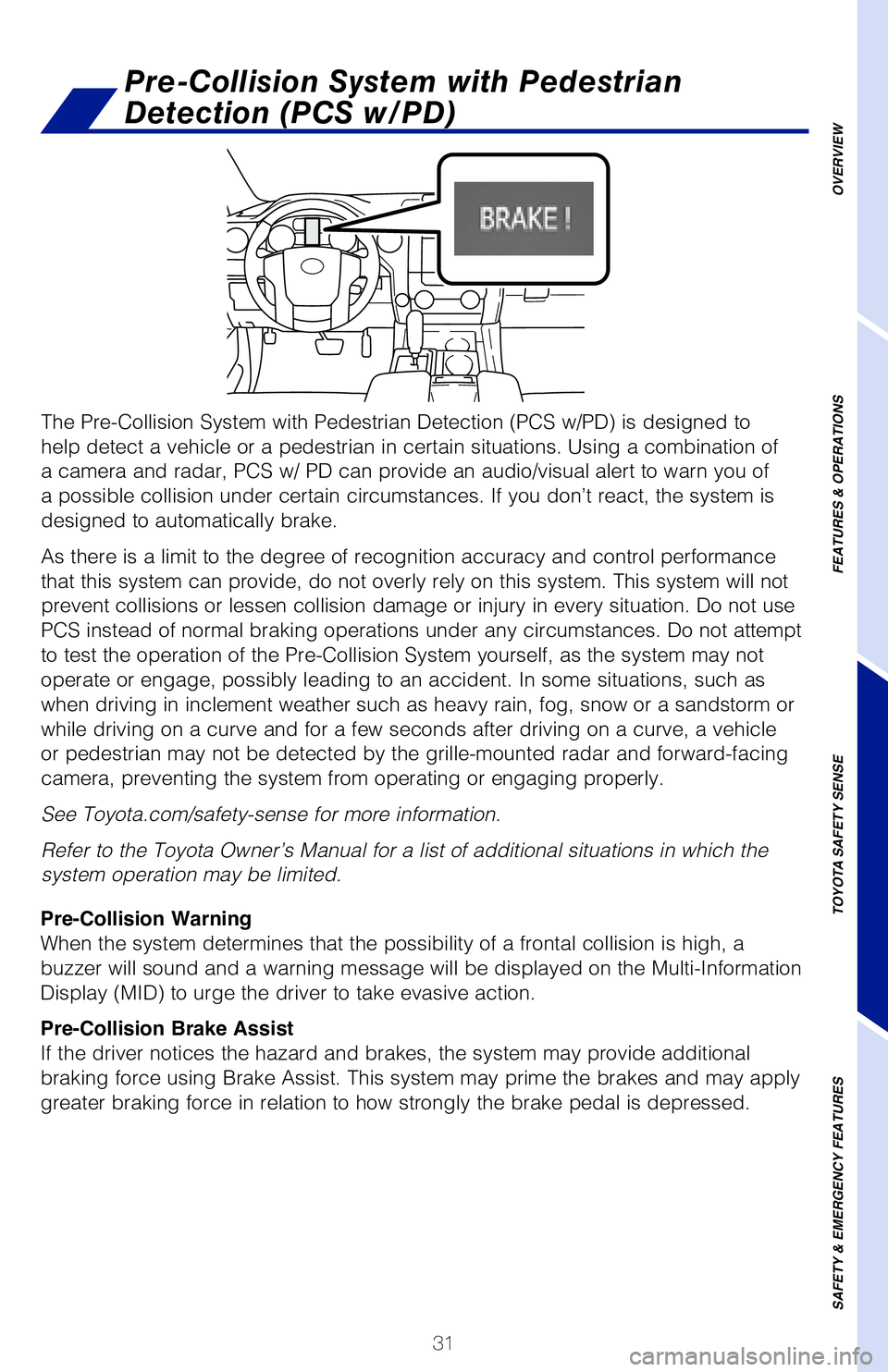
31
The Pre-Collision System with Pedestrian Detection (PCS w/PD) is desig\
ned to
help detect a vehicle or a pedestrian in certain situations. Using a com\
bination of
a camera and radar, PCS w/ PD can provide an audio/visual alert to warn \
you of
a possible collision under certain circumstances. If you don’t react,\
the system is
designed to automatically brake.
As there is a limit to the degree of recognition accuracy and control pe\
rformance
that this system can provide, do not overly rely on this system. This sy\
stem will not
prevent collisions or lessen collision damage or injury in every situati\
on. Do not use
PCS instead of normal braking operations under any circumstances. Do not\
attempt
to test the operation of the Pre-Collision System yourself, as the syste\
m may not
operate or engage, possibly leading to an accident. In some situations, \
such as
when driving in inclement weather such as heavy rain, fog, snow or a san\
dstorm or
while driving on a curve and for a few seconds after driving on a curve,\
a vehicle
or pedestrian may not be detected by the grille-mounted radar and forwar\
d-facing
camera, preventing the system from operating or engaging properly.
See Toyota.com/safety-sense for more information.
Refer to the Toyota Owner’s Manual for a list of additional situation\
s in which the
system operation may be limited.
Pre-Collision System with Pedestrian
Detection (PCS w/PD)
Quick overview-Toyota Safety Sense™ P (TSS-P)
Sensors
TSS-P combines a forward-facing camera mounted in front of the inside re\
ar view
mirror and a grille-mounted radar mounted in the front grille. These sen\
sors support
the driver assist systems.
Toyota Safety Sense
™ P (TSS-P) is a set of active safety technologies designed
to help mitigate or prevent collisions across a wide range of traffic si\
tuations, in
certain conditions. TSS-P is designed to help support the driver’s aw\
areness,
decision making and vehicle operation contributing to a safe driving exp\
erience.
Refer to the Owner’s Manual for operation, setting adjustments, limitations and
more details to understand these functions and complete safety precautions. For
more information, please go to http://www.toyota.com/safety-sense.
Automatic High Beams (AHB)AHB is designed to detect the headlights of oncoming vehicles and the ta\
il
lights of preceding vehicles and switch between high beams and low beams\
as appropriate. Pre-Collision System with Pedestrian Detection (PCS w/PD)
PCS w/PD is designed to provide alert, mitigation, and/or avoidance
support in certain conditions, when the system detects a potential
collision with a preceding vehicle is likely to occur.
The advanced grille-mounted radar system is designed to work with
the forward-facing camera to help recognize a preceding pedestrian,
and provide an alert, mitigation and/or avoidance support in certain
conditions.
Dynamic Radar Cruise Control (DRCC)
DRCC is designed to help maintain a pre-set distance to a preceding vehi\
cle
when the preceding vehicle is traveling at a lower speed.
Lane Departure Alert (LDA)
LDA is designed to provide notification when the system detects an
unintended lane departure.
OVERVIEW
FEATURES & OPERATIONS
TOYOTA SAFETY SENSE
SAFETY & EMERGENCY FEATURES
Pre-Collision Warning
When the system determines that the possibility of a frontal collision i\
s high, a
buzzer will sound and a warning message will be displayed on the Multi-I\
nformation
Display (MID) to urge the driver to take evasive action.
Pre-Collision Brake Assist
If the driver notices the hazard and brakes, the system may provide addi\
tional
braking force using Brake Assist. This system may prime the brakes and m\
ay apply
greater braking force in relation to how strongly the brake pedal is dep\
ressed.
MY21_Tundra_QRG_V2_ML_0709.indd 317/13/20 10:54 AM
Page 34 of 52
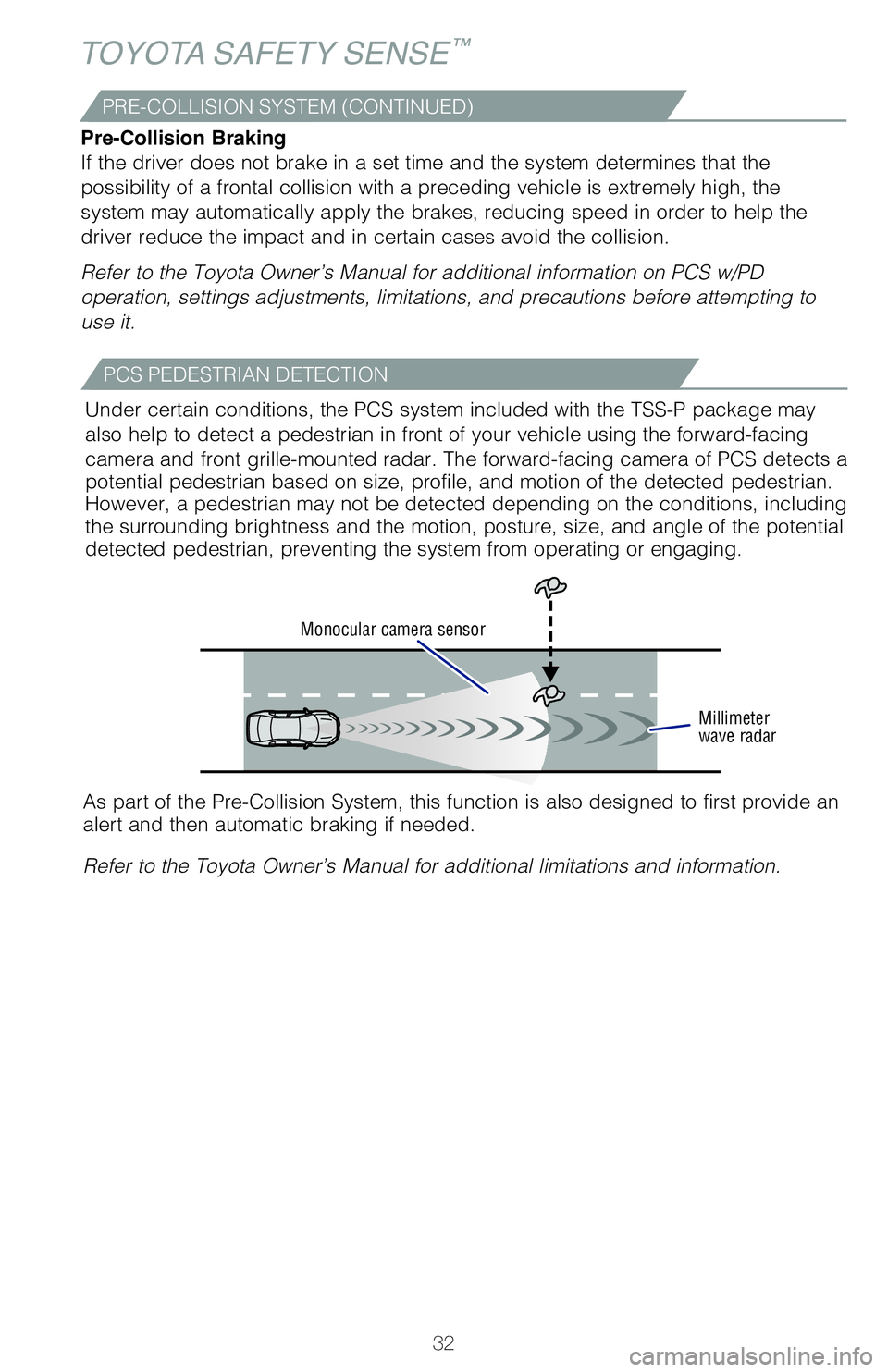
32
DISABLING PRE-COLLISION SYSTEM (PCS)
TOYOTA SAFETY SENSE™
CHANGING PCS SENSITIVITY
(1) Press “ ” switches and select “” from the Multi-Information Display (MID).
(2) Press “ ” switches and select “PCS” and then press “
.” The setting screen
is displayed.
(3) Press “ ” switches and select “Sensitivity” and then press “
” to select the
desired setting. Each time it is pressed, the response to the PCS warnin\
g timing
changes as shown above.
(4) Press “
” to go back to the menu. Also, use “ ” to switch menus or display
top screen.
Note: PCS is enabled each time the vehicle is turned on. The system can be
disabled/enabled and the alert timing of the system can be changed. (Alert
timing only, brake operation remains the same.)
(1) Press “ ” switches and select “” from the Multi-Information Display (MID).
(2) Press “ ” switches and select “PCS” and then press “
.” The setting screen
is displayed.
(3) Press “ ” switches and select “PCS” and then press “
” to select the desired
setting ON/OFF.
(4) Press “
” to go back to the menu. Also, use “ ” to switch menus or display
top screen.
Refer to the Toyota Owner’s Manual for additional information on PCS \
operation,
settings adjustments, limitations, and precautions before attempting to \
use it.
Monocular camera sensor
Millimeter
wave radar
As part of the Pre-Collision System, this function is also designed to f\
irst provide an
alert and then automatic braking if needed.
Refer to the Toyota Owner’s Manual for additional limitations and inf\
ormation.Under certain conditions, the PCS system included with the TSS-P package\
may
also help to detect a pedestrian in front of your vehicle using the forward-facing
camera and front grille-mounted radar. The forward-facing camera of PCS detect\
s a
potential pedestrian based on size, profile, and motion of the detected \
pedestrian.
However, a pedestrian may not be detected depending on the conditions, i\
ncluding
the surrounding brightness and the motion, posture, size, and angle of t\
he potential
detected pedestrian, preventing the system from operating or engaging.
PCS PEDESTRIAN DETECTION
PRE-COLLISION SYSTEM (CONTINUED)
Pre-Collision Braking
If the driver does not brake in a set time and the system determines tha\
t the
possibility of a frontal collision with a preceding vehicle is extremely\
high, the
system may automatically apply the brakes, reducing speed in order to he\
lp the
driver reduce the impact and in certain cases avoid the collision.
Refer to the Toyota Owner’s Manual for additional information on PCS \
w/PD
operation, settings adjustments, limitations, and precautions before att\
empting to
use it.
MY21_Tundra_QRG_V2_ML_0709.indd 327/13/20 10:54 AM
Page 35 of 52
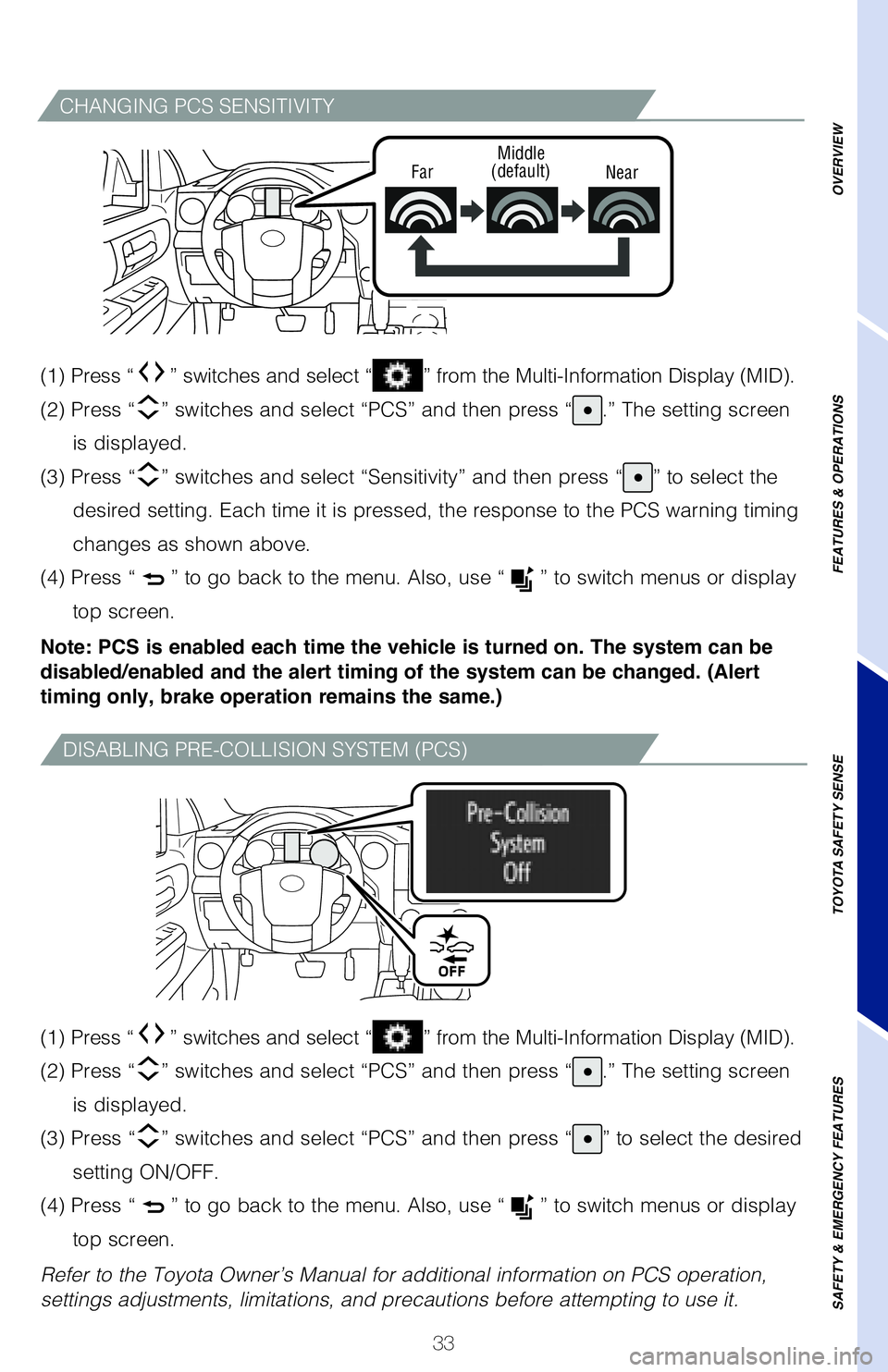
33
DISABLING PRE-COLLISION SYSTEM (PCS)
CHANGING PCS SENSITIVITY
FarMiddle
(default) Near
(1) Press “” switches and select “” from the Multi-Information Display (MID).
(2) Press “
” switches and select “PCS” and then press “.” The setting screen
is displayed.
(3) Press “
” switches and select “Sensitivity” and then press “” to select the
desired setting. Each time it is pressed, the response to the PCS warnin\
g timing
changes as shown above.
(4) Press “
” to go back to the menu. Also, use “” to switch menus or display
top screen.
Note: PCS is enabled each time the vehicle is turned on. The system can be
disabled/enabled and the alert timing of the system can be changed. (Alert
timing only, brake operation remains the same.)
(1) Press “
” switches and select “” from the Multi-Information Display (MID).
(2) Press “
” switches and select “PCS” and then press “.” The setting screen
is displayed.
(3) Press “
” switches and select “PCS” and then press “” to select the desired
setting ON/OFF.
(4) Press “
” to go back to the menu. Also, use “” to switch menus or display
top screen.
Refer to the Toyota Owner’s Manual for additional information on PCS \
operation,
settings adjustments, limitations, and precautions before attempting to \
use it.
As part of the Pre-Collision System, this function is also designed to f\
irst provide an
alert and then automatic braking if needed.
Refer to the Toyota Owner’s Manual for additional limitations and inf\
ormation. Under certain conditions, the PCS system included with the TSS-P package\
may
also help to detect a pedestrian in front of your vehicle using the forward-facing
camera and front grille-mounted radar. The forward-facing camera of PCS detect\
s a
potential pedestrian based on size, profile, and motion of the detected \
pedestrian.
However, a pedestrian may not be detected depending on the conditions, i\
ncluding
the surrounding brightness and the motion, posture, size, and angle of t\
he potential
detected pedestrian, preventing the system from operating or engaging.
OVERVIEW
FEATURES & OPERATIONS
TOYOTA SAFETY SENSE
SAFETY & EMERGENCY FEATURES
Pre-Collision Braking
If the driver does not brake in a set time and the system determines tha\
t the
possibility of a frontal collision with a preceding vehicle is extremely\
high, the
system may automatically apply the brakes, reducing speed in order to he\
lp the
driver reduce the impact and in certain cases avoid the collision.
Refer to the Toyota Owner’s Manual for additional information on PCS \
w/PD
operation, settings adjustments, limitations, and precautions before att\
empting to
use it.
MY21_Tundra_QRG_V2_ML_0709.indd 337/13/20 10:54 AM
Page 36 of 52
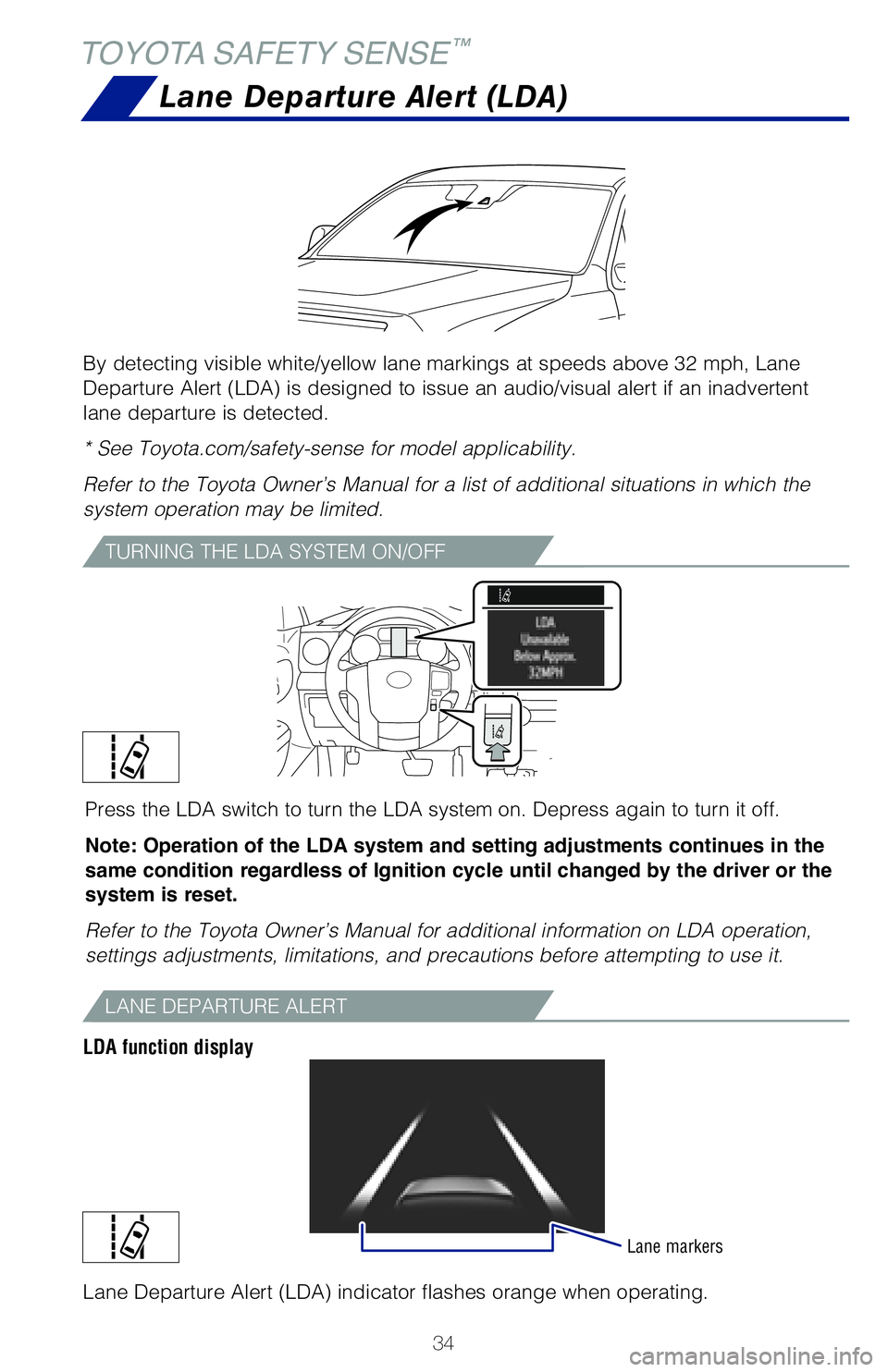
34
TOYOTA SAFETY SENSE™
ADJUSTING LDA ALERT SENSITIVITY
The driver can adjust the sensitivity of the LDA (warning) function fr\
om the
Multi-Information Display (MID) customization screen.High - Is designed to warn approximately before the front tire crosses the lane marker.
Normal - Is designed to warn approximately when the front tire crosses the lane marker.
LANE DEPARTURE ALERT (CONTINUED)
TURNING THE LDA SYSTEM ON/OFF
Press the LDA switch to turn the LDA system on. Depress again to turn it\
off.
Note: Operation of the LDA system and setting adjustments continues in the
same condition regardless of Ignition cycle until changed by the driver or the
system is reset.
Refer to the Toyota Owner’s Manual for additional information on LDA \
operation,
settings adjustments, limitations, and precautions before attempting to \
use it.
LANE DEPARTURE ALERT
LDA function display
Lane markers
(1)
Lane Departure Alert (LDA) indicator flashes orange when operating.
The LDA function displays when the Multi-Information Display (MID) is \
switched to
the driving assist system information screen.
(1) The system displays solid white lines on the LDA indicator when vi\
sible lane markers on the road are detected. A side flashes orange to alert the dri\
ver
when the vehicle deviates from its lane.
(2) The system displays outlines on the LDA indicator when lane marker\
s on the road are not detected or the function is temporarily canceled.
Note: When operation conditions are no longer met, a function may be
temporarily canceled. However, when the operation conditions are met again,
operation of the function is automatically restored. For example, LDA may not
function on the side(s) where white/yellow lines are not detectable.
(1) Press “ ” switches and select “” from the Multi-Information Display (MID).
(2) Press “ ” switches and select “LDA” and then press “
.” The setting screen
is displayed.
(3) Press “ ” switches and select “LDA sensitivity” and then press “
” to select
the desired setting.
(4) Press “
” to go back to the menu. Also, use “ ” to switch menus or display
top screen.
Note: Operation of the LDA system and setting adjustments continues in the
same condition regardless of Ignition cycle until changed by the driver or the
system is reset.
Lane Departure Alert (LDA)
By detecting visible white/yellow lane markings at speeds above 32 mph, \
Lane
Departure Alert (LDA) is designed to issue an audio/visual alert if an\
inadvertent
lane departure is detected.
* See Toyota.com/safety-sense for model applicability.
Refer to the Toyota Owner’s Manual for a list of additional situation\
s in which the
system operation may be limited.
MY21_Tundra_QRG_V2_ML_0709.indd 347/13/20 10:54 AM
Page 37 of 52
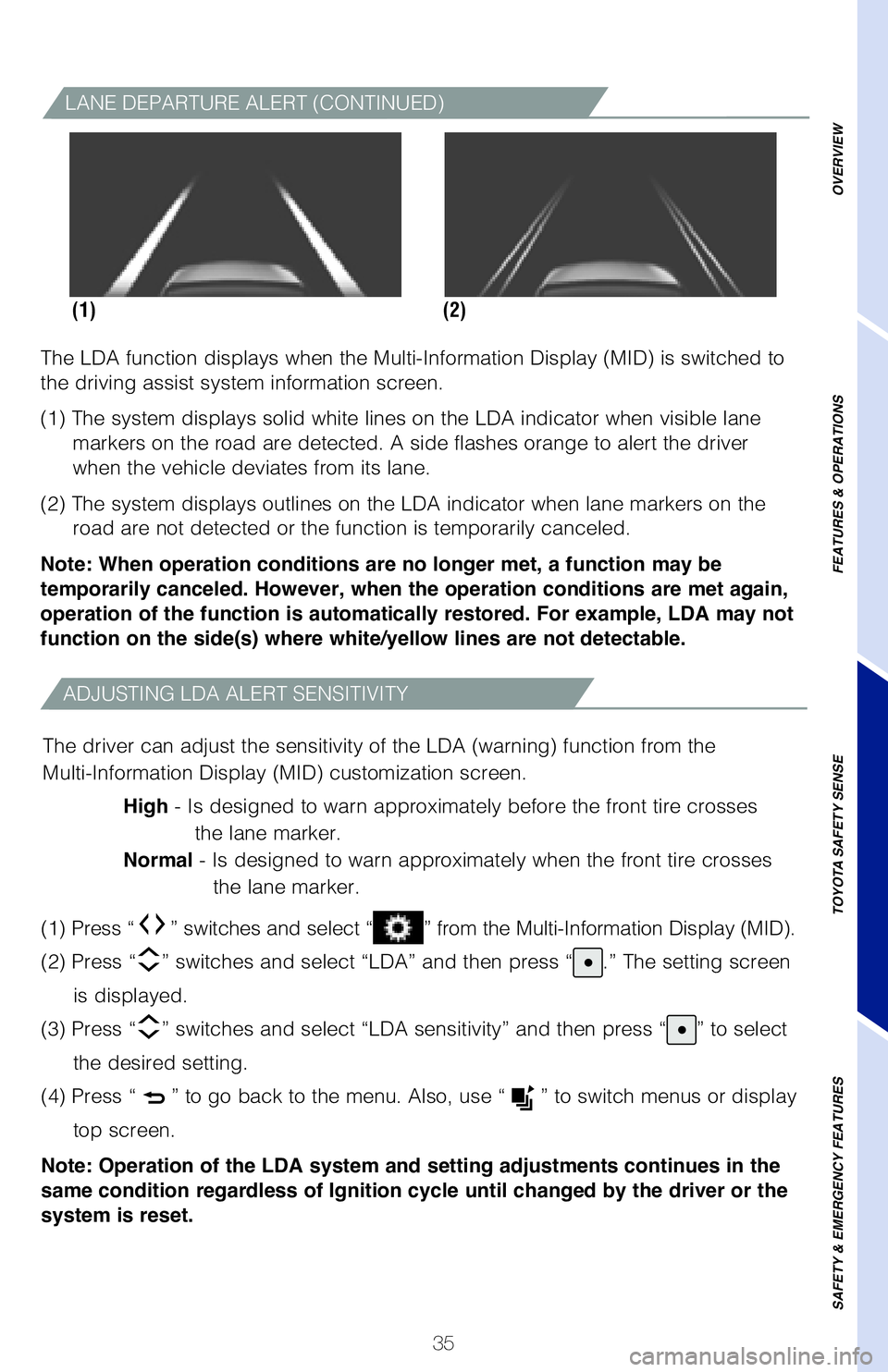
35
ADJUSTING LDA ALERT SENSITIVITY
The driver can adjust the sensitivity of the LDA (warning) function fr\
om the
Multi-Information Display (MID) customization screen.High - Is designed to warn approximately before the front tire crosses the lane marker.
Normal - Is designed to warn approximately when the front tire crosses the lane marker.
LANE DEPARTURE ALERT (CONTINUED)
Press the LDA switch to turn the LDA system on. Depress again to turn it\
off.
Note: Operation of the LDA system and setting adjustments continues in the
same condition regardless of Ignition cycle until changed by the driver or the
system is reset.
Refer to the Toyota Owner’s Manual for additional information on LDA \
operation,
settings adjustments, limitations, and precautions before attempting to \
use it.
(2)
(1)
Lane Departure Alert (LDA) indicator flashes orange when operating.
The LDA function displays when the Multi-Information Display (MID) is \
switched to
the driving assist system information screen.
(1) The system displays solid white lines on the LDA indicator when vi\
sible lane
markers on the road are detected. A side flashes orange to alert the dri\
ver
when the vehicle deviates from its lane.
(2) The system displays outlines on the LDA indicator when lane marker\
s on the road are not detected or the function is temporarily canceled.
Note: When operation conditions are no longer met, a function may be
temporarily canceled. However, when the operation conditions are met again,
operation of the function is automatically restored. For example, LDA may not
function on the side(s) where white/yellow lines are not detectable.
OVERVIEW
FEATURES & OPERATIONS
TOYOTA SAFETY SENSE
SAFETY & EMERGENCY FEATURES
(1) Press “” switches and select “” from the Multi-Information Display (MID).
(2) Press “
” switches and select “LDA” and then press “.” The setting screen
is displayed.
(3) Press “
” switches and select “LDA sensitivity” and then press “” to select
the desired setting.
(4) Press “
” to go back to the menu. Also, use “” to switch menus or display
top screen.
Note: Operation of the LDA system and setting adjustments continues in the
same condition regardless of Ignition cycle until changed by the driver or the
system is reset.
Lane Departure Alert (LDA)
By detecting visible white/yellow lane markings at speeds above 32 mph, \
Lane
Departure Alert (LDA) is designed to issue an audio/visual alert if an\
inadvertent
lane departure is detected.
* See Toyota.com/safety-sense for model applicability.
Refer to the Toyota Owner’s Manual for a list of additional situation\
s in which the
system operation may be limited.
MY21_Tundra_QRG_V2_ML_0709.indd 357/13/20 10:54 AM
Page 38 of 52
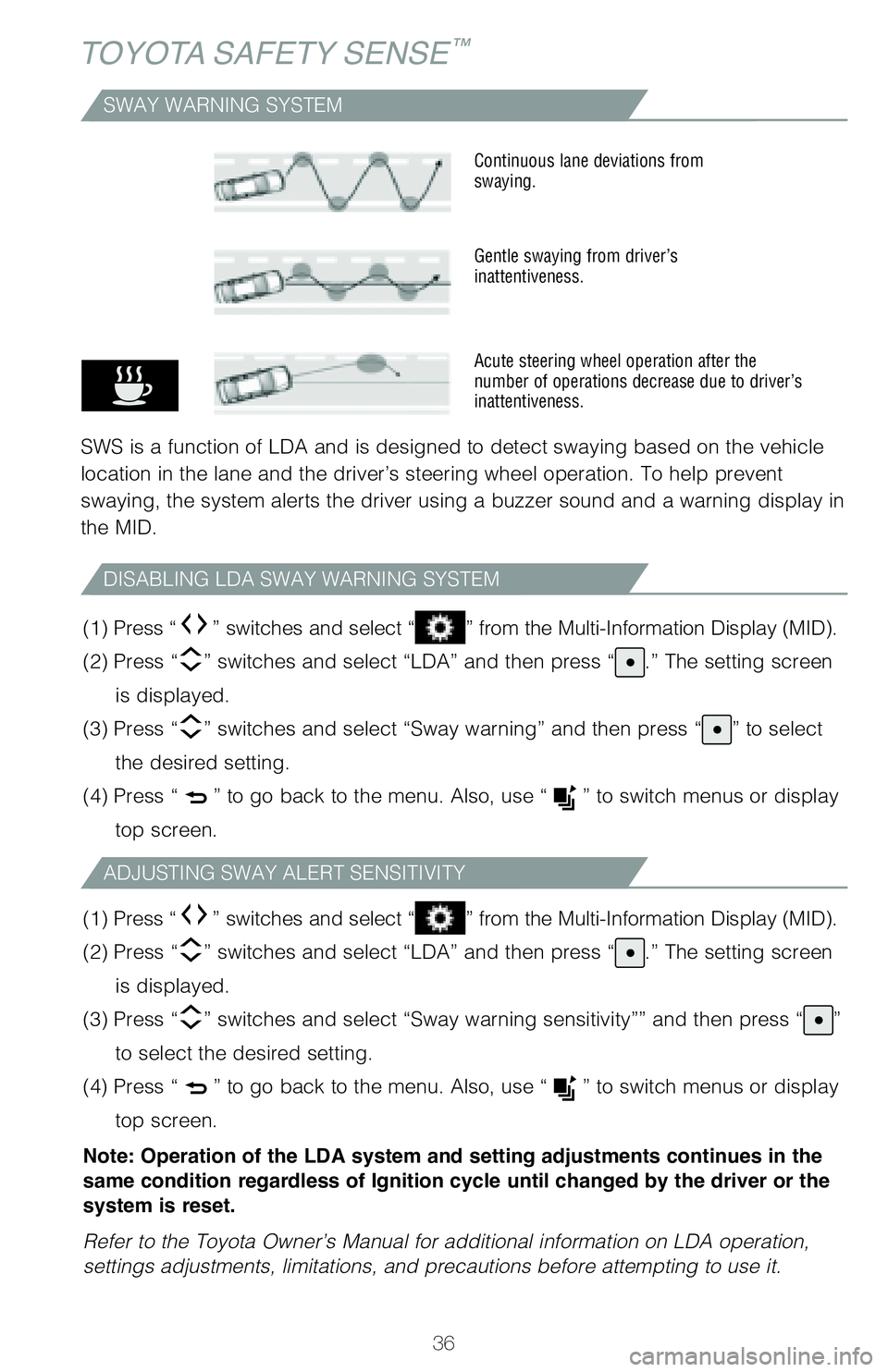
36
TOYOTA SAFETY SENSE™
TURNING SYSTEM ON/OFF
ADJUSTING SET SPEED
Intended for highway use, Dynamic Radar Cruise Control (DRCC) lets you\
drive at
a preset speed. DRCC is designed to function at speeds of 25-110 mph and\
uses
vehicle-to-vehicle distance control, helping maintain a preset distance \
from the
vehicle ahead of you.*
* Not available on all models. See Toyota.com/safety-sense for model app\
licability.
Refer to the Toyota Owner’s Manual for a list of additional situation\
s in which the
system operation may be limited.
SWAY WARNING SYSTEM
SWS is a function of LDA and is designed to detect swaying based on the \
vehicle
location in the lane and the driver’s steering wheel operation. To he\
lp prevent
swaying, the system alerts the driver using a buzzer sound and a warning\
display in
the MID.
Continuous lane deviations from
swaying.
Gentle swaying from driver’s
inattentiveness.
Acute steering wheel operation after the
number of operations decrease due to driver’s
inattentiveness.
DISABLING LDA SWAY WARNING SYSTEM
ADJUSTING SWAY ALERT SENSITIVITY
(1) Press “” switches and select “” from the Multi-Information Display (MID).
(2) Press “
” switches and select “LDA” and then press “.” The setting screen
is displayed.
(3) Press “
” switches and select “Sway warning” and then press “” to select
the desired setting.
(4) Press “
” to go back to the menu. Also, use “” to switch menus or display
top screen.
Vehicle will cruise at a set speed, decelerate to maintain selected dist\
ance from a
slower vehicle traveling in front and accelerate back up to the selected\
speed if the
vehicle in front changes lanes or speeds up.
(1) Push the ON-OFF button. The “RADAR READY” and “” indicator will come on.
(2) Push the lever down to SET speed, push it up to Resume and pull it\
or depress brake to Cancel the speed control.
(3) Push up to increase the set speed, push down to decrease (1 mph [\
1.6 km/h] or 1 km/h [0.6 mph] increments).
Refer to page 39 for switching to Constant Speed (Cruise) Control Mode\
.
1 The speed control may also be canceled by depressing the brake pedal.2 The speed control may be resumed once vehicle speed exceeds 25 mph (40 \
km/h).
(1)
Press “” switches and select “” from the Multi-Information Display (MID).
(2) Press “
” switches and select “LDA” and then press “.” The setting screen
is displayed.
(3) Press “
” switches and select “Sway warning sensitivity”” and then p\
ress “”
to select the desired setting.
(4) Press “
” to go back to the menu. Also, use “” to switch menus or display
top screen.
Note: Operation of the LDA system and setting adjustments continues in the
same condition regardless of Ignition cycle until changed by the driver or the
system is reset.
Refer to the Toyota Owner’s Manual for additional information on LDA \
operation,
settings adjustments, limitations, and precautions before attempting to \
use it.
MY21_Tundra_QRG_V2_ML_0709.indd 367/13/20 10:54 AM
Page 39 of 52
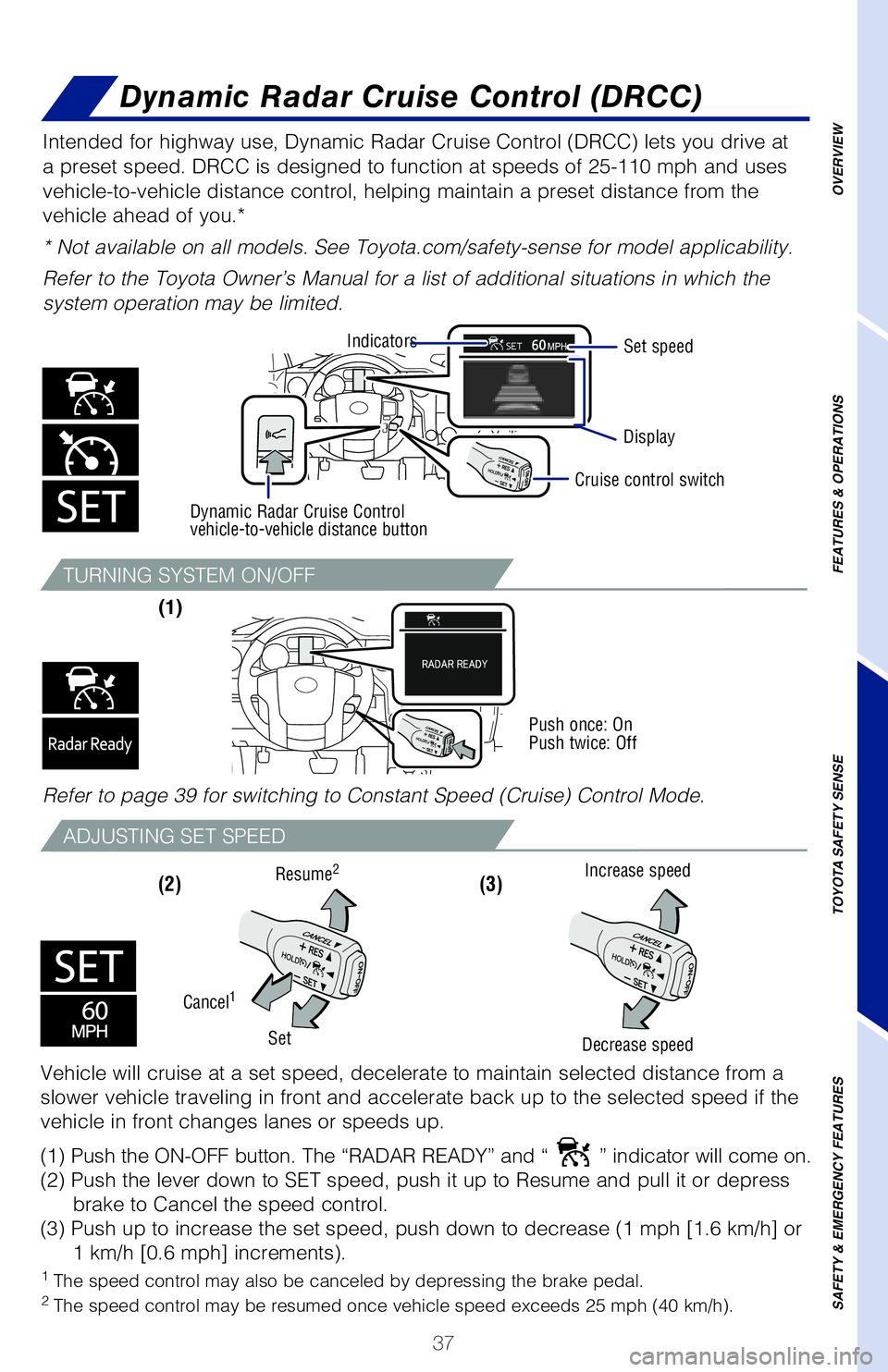
37
TURNING SYSTEM ON/OFF
ADJUSTING SET SPEED
(1)
(2) (3)
Intended for highway use, Dynamic Radar Cruise Control (DRCC) lets you drive a\
t
a preset speed. DRCC is designed to function at speeds of 25-110 mph and \
uses
vehicle-to-vehicle distance control, helping maintain a preset distance from the
vehicle ahead of you.*
* Not available on all models. See Toyota.com/safety-sense for model appl\
icability.
Refer to the Toyota Owner’s Manual for a list of additional situations in \
which the
system operation may be limited.
Increase speed
Decrease speed
Cruise control switch
SWS is a function of LDA and is designed to detect swaying based on the veh\
icle
location in the lane and the driver’s steering wheel operation. To help preve\
nt
swaying, the system alerts the driver using a buzzer sound and a warning display\
in
the MID.
Acute steering wheel operation after the
number of operations decrease due to driver’s
inattentiveness.
(1) Press “” switches and select “ ” from the Multi-Information Display (MID).
(2) Press “ ” switches and select “LDA” and then press “.” The setting screen
is displayed.
(3) Press “ ” switches and select “Sway warning” and then press “
” to select
the desired setting.
(4) Press “
” to go back to the menu. Also, use “ ” to switch menus or display
top screen.
Vehicle will cruise at a set speed, decelerate to maintain selected distance fr\
om a
slower vehicle traveling in front and accelerate back up to the selected speed\
if the
vehicle in front changes lanes or speeds up.
(1) Push the ON-OFF button. The “RADAR READY” and “
” indicator will come on.
(2) Push the lever down to SET speed, push it up to Resume and pull it or d\
epress brake to Cancel the speed control.
(3) Push up to increase the set speed, push down to decrease (1 mph [1.6 k\
m/h] or 1 km/h [0.6 mph] increments).
Cancel1
Set
Resume2
Push once: On
Push twice: Off
Refer to page 39 for switching to Constant Speed (Cruise) Control Mode.
1 The speed control may also be canceled by depressing the brake pedal.2 The speed control may be resumed once vehicle speed exceeds 25 mph (40 km/\
h).
OVERVIEW
FEATURES & OPERATIONS
TOYOTA SAFETY SENSE
SAFETY & EMERGENCY FEATURES
Dynamic Radar Cruise Control (DRCC)
(1) Press “ ” switches and select “ ” from the Multi-Information Display (MID).
(2) Press “ ” switches and select “LDA” and then press “.” The setting screen
is displayed.
(3) Press “ ” switches and select “Sway warning sensitivity”” and then press\
“
”
to select the desired setting.
(4) Press “
” to go back to the menu. Also, use “ ” to switch menus or display
top screen.
Note: Operation of the LDA system and setting adjustments continues in the
same condition regardless of Ignition cycle until changed by the driver or the
system is reset.
Refer to the Toyota Owner’s Manual for additional information on LDA opera\
tion,
settings adjustments, limitations, and precautions before attempting to use it.
Display Set speed
Dynamic Radar Cruise Control
vehicle-to-vehicle distance button
Indicators
MY21_Tundra_QRG_V2_ML_0709.indd 377/13/20 10:54 AM
Page 40 of 52
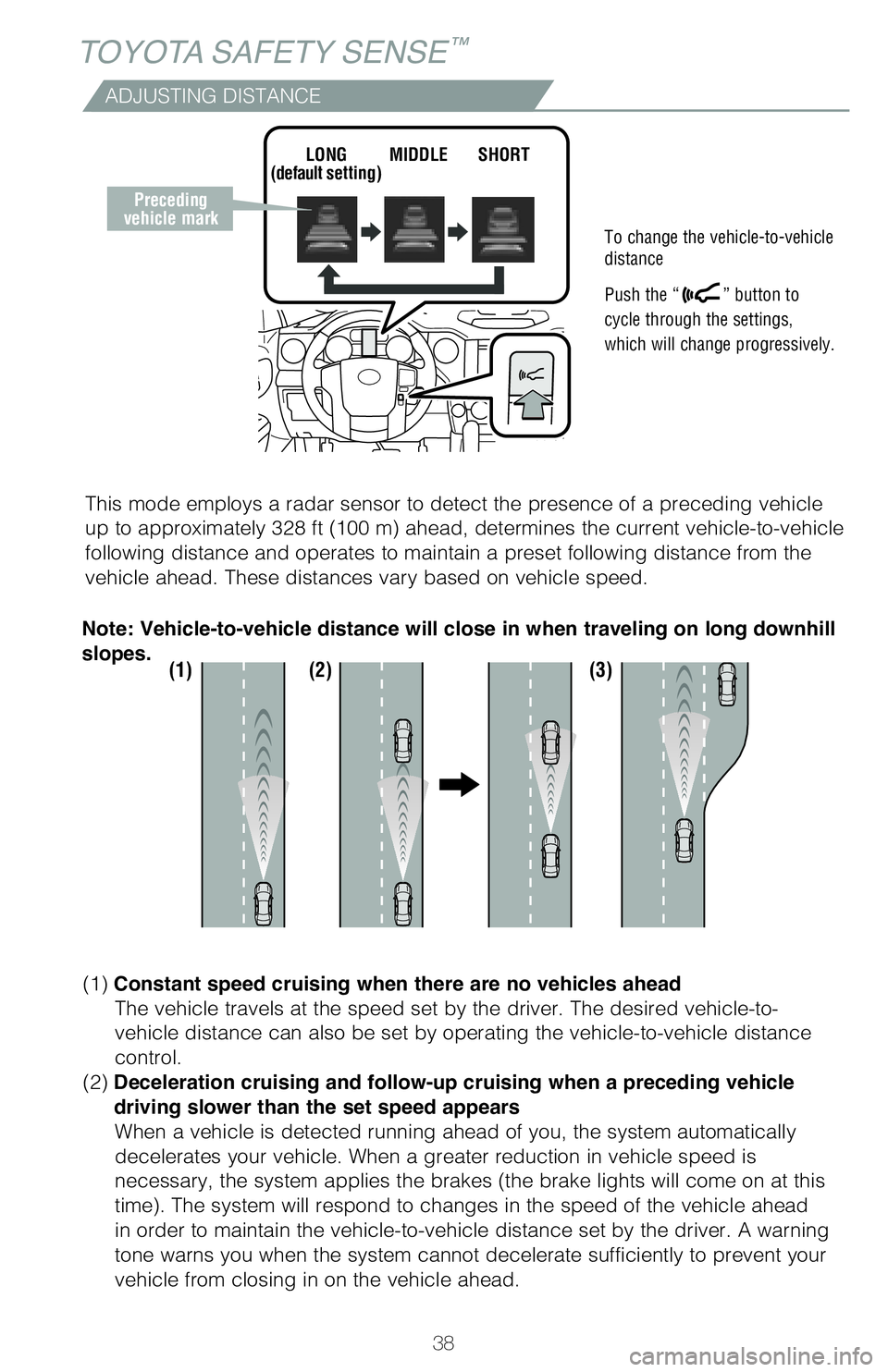
38
TOYOTA SAFETY SENSE™
ADJUSTING DISTANCE
To change the vehicle-to-vehicle
distance
Push the “
” button to
cycle through the settings,
which will change progressively.
This mode employs a radar sensor to detect the presence of a preceding v\
ehicle
up to approximately 328 ft (100 m) ahead, determines the current vehic\
le-to-vehicle
following distance and operates to maintain a preset following distance \
from the
vehicle ahead. These distances vary based on vehicle speed.
(1) (2) (3)
(1) Constant speed cruising when there are no vehicles ahead
The vehicle travels at the speed set by the driver. The desired vehicle-\
to-
vehicle distance can also be set by operating the vehicle-to-vehicle dis\
tance
control.
(2) Deceleration cruising and follow-up cruising when a preceding vehicle
driving slower than the set speed appears When a vehicle is detected running ahead of you, the system automaticall\
y
decelerates your vehicle. When a greater reduction in vehicle speed is
necessary, the system applies the brakes (the brake lights will come on\
at this
time). The system will respond to changes in the speed of the vehicle a\
head
in order to maintain the vehicle-to-vehicle distance set by the driver. \
A warning
tone warns you when the system cannot decelerate sufficiently to prevent\
your
vehicle from closing in on the vehicle ahead.
Note: Vehicle-to-vehicle distance will close in when traveling on long downhill
slopes.
Preceding
vehicle mark LONG
(default setting) MIDDLE SHORT
SETTING CONSTANT SPEED (CRUISE) CONTROL
SWITCHING TO CONSTANT SPEED (CRUISE) CONTROL MODE
Note: When your vehicle is too close to a vehicle ahead, and sufficient automatic
deceleration via the cruise control is not possible, the display will flash and the
buzzer will sound to alert the driver. An example of this would be if another driver
cuts in front of you while you are following a vehicle. Depress the brake pedal to
ensure an appropriate vehicle-to-vehicle distance.
If you are already using DRCC “,” push button again to turn the system off
first, then push and hold button for at least 1.5 seconds to switch.
Note: When the engine is turned off, it will automatically default to DRCC.
(3) Acceleration when there are no longer any preceding vehicles driving
slower than the set speed The system accelerates until the set speed is reached. The system then
returns to constant speed cruising.
DRCC ADJUSTING DISTANCE (CONTINUED)
To adjust speed or cancel, see steps (2) and (3) of ADJUSTING SET SPEED on
page 37.
Refer to the Toyota Owner’s Manual for additional information on DRCC\
operation,
settings adjustments, limitations, and precautions before attempting to \
use it.
MY21_Tundra_QRG_V2_ML_0709.indd 387/13/20 10:54 AM